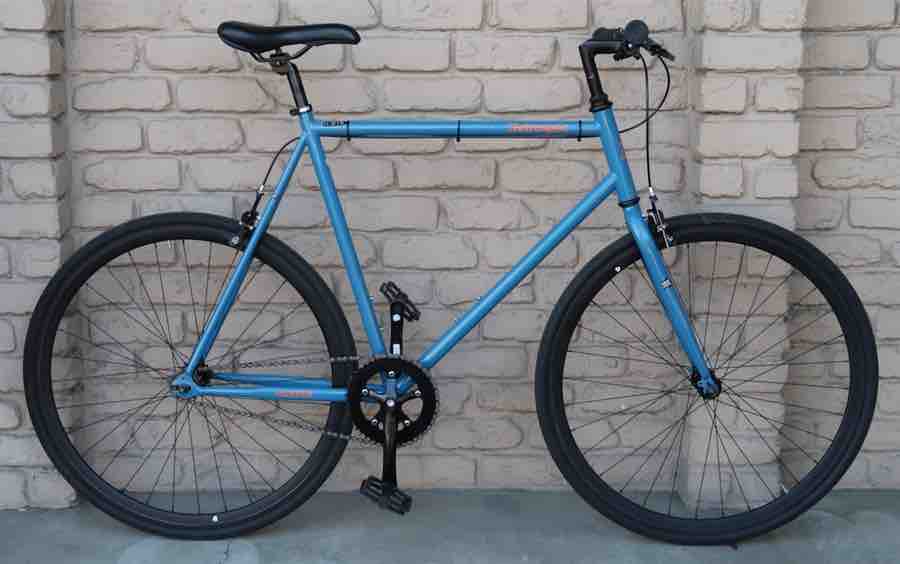Single-speed and fixed-gear bikes are similar, but there are also some key differences between them. In this post, I’ll list out the major Difference Between Single Speed And Fixed Gear and also state why you should choose one over the other.

So what is the key difference between single speed and fixed gear bikes?
Single-speed bikes only feature one gear ratio, meaning only one set is available. Riders can adjust the ratio by changing out either the rear cog or front chainring, making the bike easier or harder to pedal, depending on where they’re going. Unfortunately, there’s no way to switch between gears while riding, so riders must choose which gear works best for their intended route before leaving. Fixed gear bikes, on the other hand, feature a fixed gear ratio – meaning the rear cog is attached to the rear wheel. This makes for more efficient riding but can also make controlling it more challenging at times, particularly when braking.
| Key Features | Single Speed | Fixed Gear |
| Gear Ratio | Can be adjusted | Fixed |
| Coasting | Possible | Not possible |
| Braking | Has Standard brakes | Brakes are required |
| Control | Easy to control | More Challenging |
| Maintenance | Easier | More involved |
| Riding Experience | Versatile | More intense |
Difference Between Single Speed And Fixed Gear
Single-speed bicycles feature a drivetrain system consisting of only one sprocket in the rear wheel hub connected directly to a crank arm that turns the pedals when pedaled forward. However, there is no freewheel mechanism, so coasting isn’t possible unless you pedal backward, which can be difficult depending on your gearing ratio.
This type of bike requires minimal maintenance, as there aren’t any derailleurs or shifters to worry about tuning up or replacing due to wear and tear from use. But you cannot change gears easily like other multi-speed models (e.g, going uphill).
Fixed-gear bicycles operate similarly, except instead of having just one sprocket in the rear wheel hub, it has two: an input side where power from pedaling goes into turning both wheels simultaneously via chain tensioner or derailleur (or cog), including another output side where power exits outwards towards ground contact points such as tires or wheel sets, respectively.
It is easier than single speeds when going uphill because extra torque can be applied through the increased leverage provided by multiple cogs working together at once while still offering the same level of control during downhill sections.
Single-speed bikes are great for casual riding around town or on trails, while fixed-gear bikes are ideal for more aggressive riders who want to challenge themselves with tricks and stunts.
Is Fixed Gear Single Speed?
Yes. Fixed gear is single-speed, meaning you can only pedal forward to move the bike; coasting or pedaling backward can be very risky.
What Are Single-Speed Bikes?
Single-speed bikes feature a single gear ratio, meaning that the rider must pedal at the same rate regardless of terrain or road conditions. This makes them ideal for those who prefer a more relaxed riding experience and don’t want to worry about shifting gears while they ride.
The main benefit of single-speed bikes is their low maintenance needs compared to multi-speed bicycles, as fewer moving parts require regular servicing or adjustment.
In addition, because riders have only one gear ratio available on these bicycles, they can achieve greater efficiency when pedaling uphill than with traditional geared models; this helps conserve energy over long rides and allows for faster commutes in urban areas.
Another advantage of owning a single-speed bike is its ease of use; as you’ll only need one hand to shift gears (or none at all!), it’s much easier for beginners or casual riders who aren’t used to using multiple speeds on their bicycle yet still want an enjoyable cycling experience without having too many complicated components involved in operating it properly.
What Are Fixed-Gear Bikes?
Fixed-gear bicycles, also known as fixies, have no freewheel mechanism, and the pedals move whenever the wheels turn. What it simply means is that riders must always pedal when riding a fixed-gear bike, even when going downhill or coasting along flat terrain.
As such, fixed-gear bicycles require more effort to ride than other types of bicycles and can be difficult for novice cyclists to master.
Fixie enthusiasts often cite this increased level of difficulty compared with regular cycling as one reason why they prefer it—there is simply nothing quite like conquering tough terrain on two wheels powered solely by your efforts.
Why Are Fixed-Gear Bikes Better?
- Boost your cycling experience.
Fixed-gear bikes offer riders a unique cycling experience, as they have no freewheel and the pedals must be constantly in motion when the bike is moving. This makes for an incredibly efficient ride, as there is less energy wasted with each pedal stroke, and more of it is translated into forward momentum.
- Helps maintain balance.
Another benefit of riding a fixed-gear bicycle is that it can help improve your pedaling technique by forcing you to use both legs equally during every revolution. This helps strengthen muscles on both sides while also helping you become better at maintaining balance while riding uphill or downhill sections with ease.
Why Are Single-Speed Bikes Better?
1. Easy to maintain
The first advantage of single-speed bicycles is that they are much simpler to maintain and repair compared to other types of bikes with multiple components. With fewer moving parts, there is less chance for something to go wrong or break down while riding the bike.
2. Light in weight
The aesthetic appeal of a classic ‘single sprocket’ design combined with modern materials such as lightweight aluminum frames gives them both style points in addition to practical benefits when compared against heavier steel-framed alternatives found elsewhere in the market today.
What Is The Point Of A Single-Speed Bike?
Simplicity, Ease to maintenance, and versatility
They are a simple and efficient form of transportation. It has no gears, just one gear ratio that can be used for all types of riding.
This type of bike is popular among commuters because it requires less maintenance than multi-speed bikes, which have multiple gears and require more frequent adjustments to keep them running smoothly.
Single-speed bikes are also lightweight and affordable compared to other styles of bicycles, making them ideal for those on a budget or who don’t want the hassle associated with maintaining a complex bicycle system.
Ultimately, the point of owning a single-speed bike is its versatility—from leisurely rides around town to commuting across campus—combined with its affordability, making it an excellent choice for anyone looking into getting into cycling.
Conclusion
Both single-speed and fixed-gear bicycles offer unique advantages depending upon what kind of terrain you intend on traversing most often during cycling trips, be it smooth roads or rocky trails.
However, single-speed bikes require little maintenance compared to fixed gear, all because they only have one cog, which doesn’t require adjusting.
In the end, it comes down to personal preference, so take some time researching each type before deciding which would work best for your particular needs.
